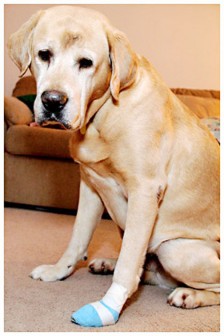Continued
In order to implement better wound management procedures, it seems appropriate that the wound healing process be understood.
Wound healing
Wound healing is the process by which damaged tissue is restored. An understanding of this process helps us to make the right decisions relative to our wound management techniques. For example, it will help us in the decision whether to close the wound or leave it open.
 We may (as scientists tend to do) classify wounds as clean, contaminated or infected. A clean wound occurs, for example, when the surgeon has to cut into tissue (usually under sterile conditions). We, of course, will not be dealing with these types of wounds.
We may (as scientists tend to do) classify wounds as clean, contaminated or infected. A clean wound occurs, for example, when the surgeon has to cut into tissue (usually under sterile conditions). We, of course, will not be dealing with these types of wounds.
A contaminated wound is described as one which has extraneous material (grass, earth, splinters, metals, etc) in it. Of course, it will have some germs in it as well, but these bacteria are not as numerous as in the infected wound. In the infected wound, the bacteria count would be more than a million per gram of tissue.
For us, of course, these differences are largely academic. Yet, it is important to know, because the heavily infected wound would need a more intense wound management procedure. Also, the level of germ intrusion and the cause of the wound (a zinc sheet or a dirty cutlass, for example) would also define the eventual methods of handling the wound.
Irrespective of the type of wound (as delineated above), the actual healing process is more or less the same. The length of the healing process will differ, especially when related to other physiological and microbiological factors. If, for example, the animal is undernourished or stressed out by environmental conditions or state of pregnancy, the healing process might take longer.

Also, a bite wound would carry germs much deeper into the tissue than, say, a superficial cutlass chop. Moreover, some germs flourish when sealed in, away from an oxygen-filled environment. Bite wounds are notorious for ‘turning out,’ because the tooth wound would have carried germs deep into the muscle, and later the entrance to the wound heals over. This closure is a haven for those germs (eg, tetanus) which flourish in an oxygen-free environment.
Our bite wound management technique would therefore (first and foremost) be geared towards keeping the wound open and cleansing and draining it repeatedly, while introducing oxygen (via hydrogen peroxide) into the wound.
Let me reiterate: even though there are different types of wounds, they all more or less undergo similar stages in the healing process. The length of time it takes for a wound to heal might differ, depending on the level of contamination, the extent of the wound, when and what type of treatment was initiated, and so on.
Inflammation is the first stage of wound healing. The layman tends to describe a wound that is oozing stuff, or one which is filled with pus, as being “full of inflammation.” Well, that is not right. The very meaning of the word suggests a red and ‘fiery’ condition (‘in flame’). As soon as the skin is broken, the body’s defence mechanism kicks into action. Firstly, the blood vessels near the wounded area constrict. They close themselves in order to stop the haemorrhaging. Soon after that, once the bleeding is under control, the blood vessels open up again and allow special defence cells (white blood cells) to migrate into the wound area to do battle with the germs that have entered the broken skin.
The second stage of wound healing is called debridement. This is not the type of word that one finds even in a good dictionary. Literally, it means removal of contaminated tissue. During this stage, very special blood cells descend upon the area and gobble up bacteria, dead cells and other debris. These cells actually migrate out of the blood vessels and launch the clean-up campaign.
For the want of a better word, the third stage of wound healing could be called repair. This phase is characterized by an actual rebuilding process. Special cells change their shape and function. Some of these cells form strands which help to build a framework to assist the migration of more cells to the area. Tiny blood vessels begin to grow into the wounded spot. Some cells secrete substances to strengthen the tissue that had been damaged. I should mention, in passing, that a healed wound never regains its original strength. It will remain 15-20 per cent weaker than the original tissue. (It is for this reason that a cut above a boxer’s eye is always especially vulnerable to another blow.) As the proliferation of cells and capillaries (tiny blood vessels) continues, new tissue is formed which is resistant to infection.
The last stage is maturation. In this final phase of wound healing, the newly laid fibres reorganize themselves along the line of tension. This process allows wound strength to increase slowly over a protracted period (even up to two years).
Enjoy the coming week.
Please implement disease preventative measures (vaccinations, routine dewormings, monthly anti-heartworm medication, etc) and adopt-a-pet from the GSPCA’s Animal Clinic and Shelter at Robb Street and Orange Walk, if you have the wherewithal to care well for the animals. Do not stray your unwanted pets, take them to the GSPCA’s Clinic and Shelter instead. If you do not wish your pet to have puppies or kittens, you may exploit the GSPCA’s free spay and neutering programme. If you see anyone being cruel to an animal, or if you need any technical information, please get in touch with the Clinic and Shelter by calling 226-4237.









